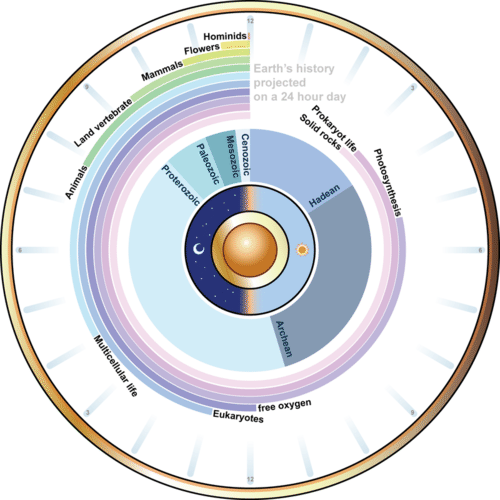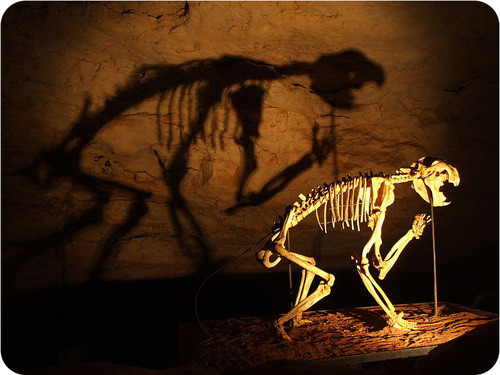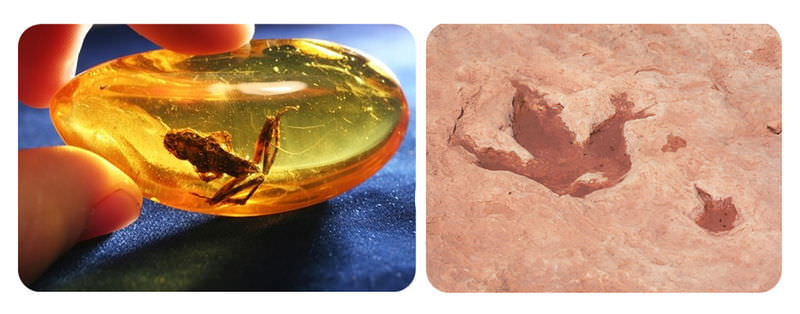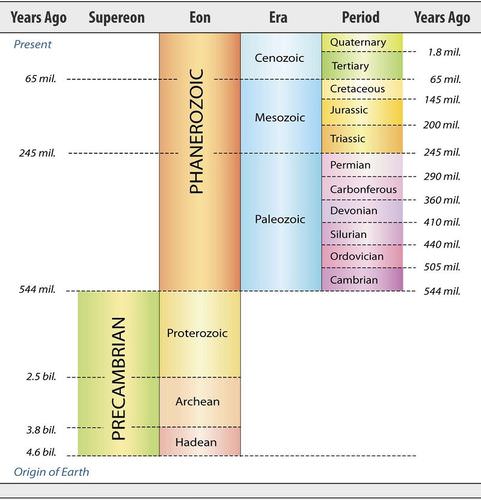5.11: History of Life
- Page ID
- 1478
\( \newcommand{\vecs}[1]{\overset { \scriptstyle \rightharpoonup} {\mathbf{#1}} } \)
\( \newcommand{\vecd}[1]{\overset{-\!-\!\rightharpoonup}{\vphantom{a}\smash {#1}}} \)
\( \newcommand{\dsum}{\displaystyle\sum\limits} \)
\( \newcommand{\dint}{\displaystyle\int\limits} \)
\( \newcommand{\dlim}{\displaystyle\lim\limits} \)
\( \newcommand{\id}{\mathrm{id}}\) \( \newcommand{\Span}{\mathrm{span}}\)
( \newcommand{\kernel}{\mathrm{null}\,}\) \( \newcommand{\range}{\mathrm{range}\,}\)
\( \newcommand{\RealPart}{\mathrm{Re}}\) \( \newcommand{\ImaginaryPart}{\mathrm{Im}}\)
\( \newcommand{\Argument}{\mathrm{Arg}}\) \( \newcommand{\norm}[1]{\| #1 \|}\)
\( \newcommand{\inner}[2]{\langle #1, #2 \rangle}\)
\( \newcommand{\Span}{\mathrm{span}}\)
\( \newcommand{\id}{\mathrm{id}}\)
\( \newcommand{\Span}{\mathrm{span}}\)
\( \newcommand{\kernel}{\mathrm{null}\,}\)
\( \newcommand{\range}{\mathrm{range}\,}\)
\( \newcommand{\RealPart}{\mathrm{Re}}\)
\( \newcommand{\ImaginaryPart}{\mathrm{Im}}\)
\( \newcommand{\Argument}{\mathrm{Arg}}\)
\( \newcommand{\norm}[1]{\| #1 \|}\)
\( \newcommand{\inner}[2]{\langle #1, #2 \rangle}\)
\( \newcommand{\Span}{\mathrm{span}}\) \( \newcommand{\AA}{\unicode[.8,0]{x212B}}\)
\( \newcommand{\vectorA}[1]{\vec{#1}} % arrow\)
\( \newcommand{\vectorAt}[1]{\vec{\text{#1}}} % arrow\)
\( \newcommand{\vectorB}[1]{\overset { \scriptstyle \rightharpoonup} {\mathbf{#1}} } \)
\( \newcommand{\vectorC}[1]{\textbf{#1}} \)
\( \newcommand{\vectorD}[1]{\overrightarrow{#1}} \)
\( \newcommand{\vectorDt}[1]{\overrightarrow{\text{#1}}} \)
\( \newcommand{\vectE}[1]{\overset{-\!-\!\rightharpoonup}{\vphantom{a}\smash{\mathbf {#1}}}} \)
\( \newcommand{\vecs}[1]{\overset { \scriptstyle \rightharpoonup} {\mathbf{#1}} } \)
\( \newcommand{\vecd}[1]{\overset{-\!-\!\rightharpoonup}{\vphantom{a}\smash {#1}}} \)
\(\newcommand{\avec}{\mathbf a}\) \(\newcommand{\bvec}{\mathbf b}\) \(\newcommand{\cvec}{\mathbf c}\) \(\newcommand{\dvec}{\mathbf d}\) \(\newcommand{\dtil}{\widetilde{\mathbf d}}\) \(\newcommand{\evec}{\mathbf e}\) \(\newcommand{\fvec}{\mathbf f}\) \(\newcommand{\nvec}{\mathbf n}\) \(\newcommand{\pvec}{\mathbf p}\) \(\newcommand{\qvec}{\mathbf q}\) \(\newcommand{\svec}{\mathbf s}\) \(\newcommand{\tvec}{\mathbf t}\) \(\newcommand{\uvec}{\mathbf u}\) \(\newcommand{\vvec}{\mathbf v}\) \(\newcommand{\wvec}{\mathbf w}\) \(\newcommand{\xvec}{\mathbf x}\) \(\newcommand{\yvec}{\mathbf y}\) \(\newcommand{\zvec}{\mathbf z}\) \(\newcommand{\rvec}{\mathbf r}\) \(\newcommand{\mvec}{\mathbf m}\) \(\newcommand{\zerovec}{\mathbf 0}\) \(\newcommand{\onevec}{\mathbf 1}\) \(\newcommand{\real}{\mathbb R}\) \(\newcommand{\twovec}[2]{\left[\begin{array}{r}#1 \\ #2 \end{array}\right]}\) \(\newcommand{\ctwovec}[2]{\left[\begin{array}{c}#1 \\ #2 \end{array}\right]}\) \(\newcommand{\threevec}[3]{\left[\begin{array}{r}#1 \\ #2 \\ #3 \end{array}\right]}\) \(\newcommand{\cthreevec}[3]{\left[\begin{array}{c}#1 \\ #2 \\ #3 \end{array}\right]}\) \(\newcommand{\fourvec}[4]{\left[\begin{array}{r}#1 \\ #2 \\ #3 \\ #4 \end{array}\right]}\) \(\newcommand{\cfourvec}[4]{\left[\begin{array}{c}#1 \\ #2 \\ #3 \\ #4 \end{array}\right]}\) \(\newcommand{\fivevec}[5]{\left[\begin{array}{r}#1 \\ #2 \\ #3 \\ #4 \\ #5 \\ \end{array}\right]}\) \(\newcommand{\cfivevec}[5]{\left[\begin{array}{c}#1 \\ #2 \\ #3 \\ #4 \\ #5 \\ \end{array}\right]}\) \(\newcommand{\mattwo}[4]{\left[\begin{array}{rr}#1 \amp #2 \\ #3 \amp #4 \\ \end{array}\right]}\) \(\newcommand{\laspan}[1]{\text{Span}\{#1\}}\) \(\newcommand{\bcal}{\cal B}\) \(\newcommand{\ccal}{\cal C}\) \(\newcommand{\scal}{\cal S}\) \(\newcommand{\wcal}{\cal W}\) \(\newcommand{\ecal}{\cal E}\) \(\newcommand{\coords}[2]{\left\{#1\right\}_{#2}}\) \(\newcommand{\gray}[1]{\color{gray}{#1}}\) \(\newcommand{\lgray}[1]{\color{lightgray}{#1}}\) \(\newcommand{\rank}{\operatorname{rank}}\) \(\newcommand{\row}{\text{Row}}\) \(\newcommand{\col}{\text{Col}}\) \(\renewcommand{\row}{\text{Row}}\) \(\newcommand{\nul}{\text{Nul}}\) \(\newcommand{\var}{\text{Var}}\) \(\newcommand{\corr}{\text{corr}}\) \(\newcommand{\len}[1]{\left|#1\right|}\) \(\newcommand{\bbar}{\overline{\bvec}}\) \(\newcommand{\bhat}{\widehat{\bvec}}\) \(\newcommand{\bperp}{\bvec^\perp}\) \(\newcommand{\xhat}{\widehat{\xvec}}\) \(\newcommand{\vhat}{\widehat{\vvec}}\) \(\newcommand{\uhat}{\widehat{\uvec}}\) \(\newcommand{\what}{\widehat{\wvec}}\) \(\newcommand{\Sighat}{\widehat{\Sigma}}\) \(\newcommand{\lt}{<}\) \(\newcommand{\gt}{>}\) \(\newcommand{\amp}{&}\) \(\definecolor{fillinmathshade}{gray}{0.9}\)
How do we learn about the past?
We study the remains of things that existed many years ago. The Ruins of Pompeii have given archeologists, historians, and other scholars a tremendous amount of information about life two thousand years ago. This section discusses studying things that are many thousands of years older than these remains.
Earth in a Day
It’s hard to grasp the vast amounts of time since Earth formed and life first appeared on its surface. It may help to think of Earth’s history as a 24-hour day, as shown in Figure below. Humans would have appeared only during the last minute of that day. If we are such newcomers on planet Earth, how do we know about the vast period of time that went before us? How have we learned about the distant past?
 History of Earth in a Day. In this model of Earth’s history, the planet formed at midnight. What time was it when the first prokaryotes evolved?
History of Earth in a Day. In this model of Earth’s history, the planet formed at midnight. What time was it when the first prokaryotes evolved?Learning About the Past
Much of what we know about the history of life on Earth is based on the fossil record. Detailed knowledge of modern organisms also helps us understand how life evolved.
The Fossil Record
Fossils are the preserved remains or traces of organisms that lived in the past. The soft parts of organisms almost always decompose quickly after death. On occasion, the hard parts—mainly bones, teeth, or shells—remain long enough to mineralize and form fossils. An example of a complete fossil skeleton is shown in Figure below. The fossil record is the record of life that unfolded over four billion years and pieced back together through the analysis of fossils.
 Extinct Lion Fossil. This fossilized skeleton represents an extinct lion species. It is rare for fossils to be so complete and well preserved as this one.
Extinct Lion Fossil. This fossilized skeleton represents an extinct lion species. It is rare for fossils to be so complete and well preserved as this one.To be preserved as fossils, remains must be covered quickly by sediments or preserved in some other way. For example, they may be frozen in glaciers or trapped in tree resin, like the frog in Figure below. Sometimes traces of organisms—such as footprints or burrows—are preserved (see the fossil footprints in Figure below). The conditions required for fossils to form rarely occur. Therefore, the chance of an organism being preserved as a fossil is very low.
 The photo on the left shows an ancient frog trapped in hardened tree resin, or amber. The photo on the right shows the fossil footprints of a dinosaur.
The photo on the left shows an ancient frog trapped in hardened tree resin, or amber. The photo on the right shows the fossil footprints of a dinosaur.In order for fossils to “tell” us the story of life, they must be dated. Then they can help scientists reconstruct how life changed over time. Fossils can be dated in two different ways: relative dating and absolute dating. Both are described below.
- Relative dating determines which of two fossils is older or younger than the other, but not their age in years. Relative dating is based on the positions of fossils in rock layers. Lower layers were laid down earlier, so they are assumed to contain older fossils. This is illustrated in Figure below.
- Absolute dating determines about how long ago a fossil organism lived. This gives the fossil an approximate age in years. Absolute dating is often based on the amount of carbon-14 or other radioactive element that remains in a fossil.
 Relative Dating Using Rock Layers. Relative dating establishes which of two fossils is older than the other. It is based on the rock layers in which the fossils formed.
Relative Dating Using Rock Layers. Relative dating establishes which of two fossils is older than the other. It is based on the rock layers in which the fossils formed.Molecular Clocks
Evidence from the fossil record can be combined with data from molecular clocks. A molecular clock uses DNA sequences (or the proteins they encode) to estimate relatedness among species. Molecular clocks estimate the time in geologic history when related species diverged from a common ancestor. Molecular clocks are based on the assumption that mutations accumulate through time at a steady average rate for a given region of DNA. Species that have accumulated greater differences in their DNA sequences are assumed to have diverged from their common ancestor in the more distant past. Molecular clocks based on different regions of DNA may be used together for more accuracy.
Consider the example in Table below. The table shows how similar the DNA of several animal species is to human DNA. Based on these data, which organism do you think shared the most recent common ancestor with humans?
| Organism | Similarity with Human DNA (percent) |
|---|---|
| Chimpanzee | 98 |
| Mouse | 85 |
| Chicken | 60 |
| Fruit Fly | 44 |
Geologic Time Scale
Another tool for understanding the history of Earth and its life is the geologic time scale, shown in Figure below. The geologic time scale divides Earth’s history into divisions (such as eons, eras, and periods) that are based on major changes in geology, climate, and the evolution of life. It organizes Earth’s history and the evolution of life on the basis of important events instead of time alone. It also allows more focus to be placed on recent events, about which we know the most.
 Geologic Time Scale. The geologic time scale divides Earth’s history into units that reflect major changes in Earth and its life forms. During which eon did Earth form? What is the present era?
Geologic Time Scale. The geologic time scale divides Earth’s history into units that reflect major changes in Earth and its life forms. During which eon did Earth form? What is the present era?Summary
- Much of what we know about the history of life on Earth is based on the fossil record.
- Molecular clocks are used to estimate how long it has been since two species diverged from a common ancestor.
- The geologic time scale is another important tool for understanding the history of life on Earth.
Review
1. What are fossils?
2. Describe how fossils form.
3. Distinguish relative dating from absolute dating.
4. This table shows DNA sequence comparisons for some hypothetical species. Based on the data, describe evolutionary relationships between Species A and the other four species. Explain your answer.
| Species | DNA Similarity with Species A |
|---|---|
| Species B | 42% |
| Species C | 85% |
| Species D | 67% |
| Species E | 91% |
5. Describe the geologic time scale.
Resources
| Image | Reference | Attributions |
 |
[Figure 1] | Credit: Mariana Ruiz Villarreal (LadyofHats) for CK-12 Foundation;Hana Zavadska;Ernst Haeckel Source: CK-12 Foundation ; http://en.Wikipedia.org/wiki/File:Age-of-Man-wiki.jpg License: CC BY-NC 3.0 |
 |
[Figure 2] | Credit: Mariana Ruiz Villarreal (LadyofHats) for CK-12 Foundation Source: CK-12 Foundation License: CC BY-NC 3.0 |
 |
[Figure 3] | Credit: User:Karora/Wikimedia Commons Source: commons.wikimedia.org/wiki/File:Thylacoleo_skeleton_in_Naracoorte_Caves.jpg License: Public Domain |
 |
[Figure 4] | Credit: Frog in resin: Image copyright Galyna Andrushko, 2014; Footprint: Edmondo Gnerre Source: Frog in resin: http://www.shutterstock.com ; Footprint: commons.wikimedia.org/wiki/File:Tuba_City_Dinosaur_Track.jpg License: (Frog in resin) License from Shutterstock; (Footprint) CC BY 2.0 |
 |
[Figure 5] | Credit: Mariana Ruiz Villarreal (LadyofHats) for CK-12 Foundation Source: CK-12 Foundation License: CC BY-NC 3.0 |
 |
[Figure 6] | Credit: Hana Zavadska Source: CK-12 Foundation License: CC BY-NC 3.0 |

